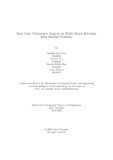| dc.contributor.advisor | Hossain, Muhammad Iqbal | |
| dc.contributor.author | Suvra, Debashis Kar | |
| dc.contributor.author | Sen, Tanusree | |
| dc.contributor.author | Mou, Maysha Maliha | |
| dc.contributor.author | Rahman, Asifur | |
| dc.date.accessioned | 2021-07-03T15:50:17Z | |
| dc.date.available | 2021-07-03T15:50:17Z | |
| dc.date.copyright | 2020 | |
| dc.date.issued | 2020-04 | |
| dc.identifier.other | ID 16301009 | |
| dc.identifier.other | ID 15201046 | |
| dc.identifier.other | ID 19241028 | |
| dc.identifier.other | ID 20141017 | |
| dc.identifier.uri | http://hdl.handle.net/10361/14730 | |
| dc.description | This thesis is submitted in partial fulfillment of the requirements for the degree of Bachelor of Science in Computer Science and Engineering, 2020. | en_US |
| dc.description | Cataloged from PDF version of thesis. | |
| dc.description | Includes bibliographical references (pages 50-52). | |
| dc.description.abstract | In recent years, Distributed Denial of service (DDoS) attacks have led to a tremendous
financial loss in some industries and governments. Such as banks, universities,
news and media publications, financial services, political or governmental servers.
DDoS attack is one of the biggest threats for cyber security nowadays. It is a malicious
act that slows down the server, makes loss of confidential data and makes
reputation damage to a brand. With the advancement of developing technologies for
example cloud computing, Internet of things (IoT), Artificial intelligence attackers
can launch attacks very easily with lower cost. However, it is challenging to detect
DDoS trafic as it is similar to normal trafic. In this era, we rely on the internet
services. Attackers send a huge volume of trafic at the same time to a speci c
network and make the network null and void. So that the server cannot respond
to the actual users. As a result, clients cannot get the services from that server. It
is very essential to detect DDoS attacks and secure servers from losing important
information and data. However, many detection techniques are available for preventing
the attack. But it is very challenging to choose one method among those
as some are time efficient and some are result oriented. In our paper, we mainly
focused on the top machine learning classification algorithms and evaluated the best
model according to the dataset. The experimental result shows that the Decision
Tree algorithm achieved the excellent accuracy of 98.50 percent with very less time
consumption. Therefore, we are using a better approach to detect DDoS attacks in
real time. | en_US |
| dc.description.statementofresponsibility | Debashis Kar Suvra | |
| dc.description.statementofresponsibility | Tanusree Sen | |
| dc.description.statementofresponsibility | Maysha Maliha Mou | |
| dc.description.statementofresponsibility | Asifur Rahman | |
| dc.format.extent | 52 pages | |
| dc.language.iso | en | en_US |
| dc.publisher | Brac University | en_US |
| dc.rights | Brac University theses are protected by copyright. They may be viewed from this source for any purpose, but reproduction or distribution in any format is prohibited without written permission. | |
| dc.subject | DDoS attacks | en_US |
| dc.subject | Detection | en_US |
| dc.subject | Artificial intelligence | en_US |
| dc.subject.lcsh | Machine learning. | |
| dc.title | Real time performance analysis on DDoS attack detection using machine learning | en_US |
| dc.type | Thesis | en_US |
| dc.contributor.department | Department of Computer Science and Engineering, Brac University | |
| dc.description.degree | B. Computer Science | |

